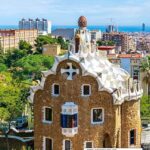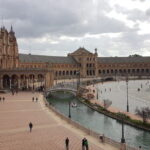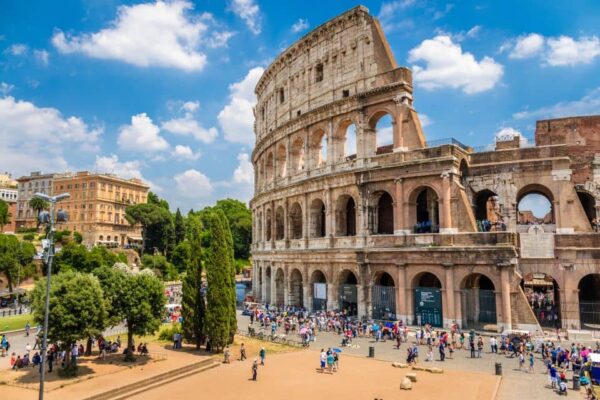With its rich tapestry of history, art, and culture, the city of Rome has captivated travelers for centuries. Its ancient ruins, vibrant piazzas, and world-renowned cuisine make it a timeless destination that continues to inspire awe and admiration.
From the iconic Colosseum to the stunning architecture of the Vatican, Rome offers a glimpse into the grandeur of a bygone era. Each cobblestone street tells a story, inviting visitors to explore the layers of history that define this magnificent city.
The Rich History of Rome: From Ancient Times to Modern Day

The history of Rome is not merely a chronicle of events but a profound narrative interwoven with the threads of culture, power, and resilience. Established over 2,700 years ago, Rome's journey from a small settlement on the banks of the Tiber River to the epicenter of a vast empire is a testament to human ambition and ingenuity. This transformation was marked by significant milestones, including the founding of the Roman Republic in 509 BC and the transition to the Roman Empire in 27 BC.
Throughout the centuries, Rome has been a cradle of innovation, influencing governance, architecture, and law across the globe. Key contributions include:
- The establishment of legal frameworks that underpin modern democracies.
- Architectural marvels such as aqueducts and roads, many of which still serve their purpose today.
- The integration of diverse cultures, which enriched Roman society and reflected its cosmopolitan spirit.
As we journey into the modern era, Rome continues to evolve while paying homage to its storied past. The city's rich history is celebrated through various institutions and events, including:
- World Heritage Sites that preserve ancient monuments.
- Annual festivals that revive historical traditions, showcasing the vibrant culture.
- Art exhibitions that connect contemporary creators with the legacy of masters like Michelangelo and Raphael.
Today, Rome stands as a living museum, where the ancient and modern coexist harmoniously. Visitors are not only drawn to its historical landmarks but also to its dynamic culture, which reflects the city’s ability to adapt and thrive through the ages. In this way, Rome is not just a destination; it is an enduring symbol of human achievement and creativity.
Top 10 Must-See Attractions in Rome for Every Traveler
When visiting Rome, certain attractions are simply unmissable. From ancient ruins to religious landmarks, the city's rich heritage offers something for every traveler. Here are the top 10 must-see attractions that should be on your itinerary:
- The Colosseum: Immerse yourself in the grandeur of this ancient amphitheater, where gladiators once battled.
- The Vatican City: Home to St. Peter's Basilica and the Sistine Chapel, it's a spiritual and artistic epicenter.
- The Roman Forum: Walk through the heart of ancient Rome and explore the remnants of important political structures.
- The Pantheon: Marvel at this architectural masterpiece, renowned for its immense dome and stunning oculus.
- Piazza Navona: Enjoy the vibrant atmosphere and admire the beautiful fountains and baroque buildings.
- The Trevi Fountain: Toss a coin into the fountain to ensure your return to this magnificent city.
- The Spanish Steps: Climb the iconic steps and enjoy the views of the surrounding area.
- The Borghese Gallery: Discover an impressive collection of art, including works by Caravaggio and Bernini.
- Trastevere: Experience the charm of this neighborhood with its narrow streets, lively squares, and authentic Roman cuisine.
- The Catacombs: Explore the ancient burial sites that reveal the early Christian history of Rome.
Each of these attractions offers a unique perspective on Rome's storied past and vibrant present. Visitors are encouraged to take their time, allowing the city’s history and culture to unfold at a leisurely pace. Whether you’re a history buff or a first-time traveler, these sites promise to leave a lasting impression and an appreciation for the timeless beauty of Rome.
Beyond just sightseeing, travelers can enjoy local culinary delights at nearby trattorias or indulge in gelato while strolling through the picturesque streets. Engaging with locals and participating in cultural experiences, such as cooking classes or guided tours, can further enrich your visit. With countless stories embedded in its walls, Rome invites every traveler to uncover its secrets and embrace its myriad of experiences.
Culinary Delights: Exploring Traditional Roman Cuisine

Traditional Roman cuisine is a celebration of simple yet flavorful ingredients that reflect the region's agricultural heritage. The dishes are often crafted with local produce, meats, and spices, offering a unique gastronomic experience. Some beloved staples include:
- Carbonara: A creamy pasta dish made with eggs, cheese, pancetta, and pepper.
- Cacio e Pepe: A minimalist combination of pasta, cheese, and freshly cracked pepper.
- Roman-style artichokes: Cooked in a savory blend of herbs and spices, they are a seasonal delicacy.
One of the hallmarks of Roman cuisine is its emphasis on fresh and seasonal ingredients. Local markets, such as Campo de' Fiori, provide an abundance of fruits, vegetables, and artisanal products. Visitors can find:
- Fresh produce: Including tomatoes, eggplants, and zucchini during the summer months.
- Handmade pasta: Often available from local vendors, showcasing traditional techniques.
- Local cheeses: Such as Pecorino Romano, which adds a distinctive flavor to many dishes.
Dining in Rome transcends mere sustenance; it is a cultural ritual. Traditional meals are often enjoyed in a leisurely manner, allowing diners to savor each bite and engage in conversation. Some common dining experiences include:
- Trattorias: Family-run establishments where home-cooked meals are served in a cozy atmosphere.
- Enotecas: Wine bars that offer regional wines paired with local delicacies.
- Pizzerias: Known for their thin-crust pizza, often enjoyed al taglio (by the slice).
As Rome’s culinary scene continues to evolve, chefs blend traditional recipes with modern techniques, creating exciting interpretations of classic dishes. This fusion results in a dynamic food culture that honors its roots while inviting innovation. Whether indulging in a hearty meal in Trastevere or enjoying a gelato on a warm evening, Rome offers a culinary journey that delights the senses.
A Guide to Rome's Iconic Landmarks: Colosseum, Vatican, and More
Rome is a city filled with remarkable landmarks that reflect its illustrious past and vibrant present. Among the most significant is the Colosseum, an architectural marvel that once hosted gladiatorial contests. This iconic structure stands as a symbol of ancient Rome's might and ingenuity. Visitors can explore its vast arena and learn about the fascinating history that echoes within its walls, making it a must-visit for anyone wanting to understand the heart of Roman culture.
Another essential destination is the Vatican City, the spiritual center of the Catholic Church. This independent city-state houses the magnificent St. Peter's Basilica and the awe-inspiring Sistine Chapel, famed for Michelangelo’s breathtaking ceiling. While visiting, don't miss the chance to stroll through the Vatican Museums, where art from centuries of history is on display. Each corner of the Vatican reveals a new facet of artistry and devotion, inviting reflection and admiration.
Beyond these iconic sites, Rome is dotted with hidden gems that offer unique experiences. Explore the ancient Roman Forum, where the ruins of temples and public spaces tell stories of daily life in the Empire. Alternatively, wander the charming streets of Trastevere, known for its vibrant atmosphere and authentic Roman cuisine. Here, visitors can immerse themselves in local culture, enjoying the lively squares and quaint alleyways that capture the essence of Roman life.
To fully appreciate the grandeur of Rome, consider participating in guided tours or cultural experiences. Engaging with knowledgeable locals can provide deeper insights into the city's history and traditions. Whether you’re standing in front of the Colosseum or sipping espresso in a piazza, each moment in Rome is an opportunity to connect with its rich heritage. Rome is not just a collection of landmarks; it is a living tapestry of history, art, and community waiting to be explored.
The Best Time to Visit Rome: Weather, Events, and Tips

The best time to visit Rome largely depends on your preferences for weather and activities. Generally, the months of April to June and September to October offer pleasant temperatures, making it ideal for exploring outdoor attractions. During spring and fall, visitors can enjoy fewer crowds while experiencing the vibrant local culture through various festivals and events.
Weather-wise, summer can be quite hot, with temperatures often exceeding 30°C (86°F), which might be uncomfortable for some. However, this season also brings numerous outdoor events and concerts, showcasing the city's lively atmosphere. If you prefer milder weather and don't mind occasional rain, visiting in late fall or early spring can be a great alternative, allowing for a more comfortable exploration of Rome's historical sites.
When planning your trip, consider the following tips to enhance your experience:
- Book in advance: Popular attractions can sell out quickly, especially during peak tourist seasons.
- Check local events: Festivals like the Roman Summer or the Feast of Santa Maria in Trastevere can provide unique cultural experiences.
- Be mindful of siesta times: Many shops and restaurants may close in the afternoon, typically between 1 PM and 4 PM.
Ultimately, the best time to visit Rome hinges on your interests, whether they be pleasant weather for sightseeing or experiencing the city's vibrant festivals. With its rich history and dynamic culture, Rome promises unforgettable experiences year-round.
Exploring Rome's Hidden Gems: Off-the-Beaten-Path Experiences
While many tourists flock to Rome’s well-trodden landmarks, the city's hidden gems offer a unique glimpse into its authentic charm. One such treasure is the Quartiere Coppedè, an eclectic neighborhood characterized by its whimsical architecture, merging styles from Art Nouveau to Baroque. Wandering through its streets allows visitors to uncover stunning buildings adorned with intricate details and vibrant mosaics that often go unnoticed.
Another off-the-beaten-path experience awaits at the Palazzo Doria Pamphili, a lesser-known museum housing a remarkable collection of art, including works by Caravaggio and Raphael. This privately owned palace immerses visitors in the opulence of Roman aristocracy, showcasing not just art, but also the rich history of its former inhabitants. To enhance your visit, consider exploring these hidden highlights:
- Seek out local artisans in the Monti neighborhood, where charming boutiques offer handmade crafts.
- Visit the tranquil Orto Botanico, a botanical garden perfect for a peaceful retreat from the city’s hustle.
- Discover the ancient Basilica di San Clemente, which features layers of history from Roman times through the Middle Ages.
As you delve deeper into the lesser-known aspects of Rome, don’t miss the opportunity to immerse yourself in local traditions. Attend a cooking class to learn how to make classic Roman dishes or join a guided tour that explores the city’s fascinating street art scene. These experiences provide a perfect balance to the more conventional sightseeing, allowing you to understand the nuances of Roman culture and everyday life.
En este contexto, te invitamos a ver un video que explora a fondo la fascinante historia y cultura de Roma.
 London
London Ibiza
Ibiza Descubriendo los Tesoros Ocultos de Barcelona: Una Aventura Auténtica
Descubriendo los Tesoros Ocultos de Barcelona: Una Aventura Auténtica Paris
Paris Dubai
Dubai Granada: An Enchanting Blend of Arab History and Natural Beauty
Granada: An Enchanting Blend of Arab History and Natural Beauty San Sebastián: Discover the Delights of This Charming Destination in Northern Spain
San Sebastián: Discover the Delights of This Charming Destination in Northern SpainSi quieres conocer otros artículos parecidos a Rome puedes visitar la categoría Top destinations.


Deja una respuesta